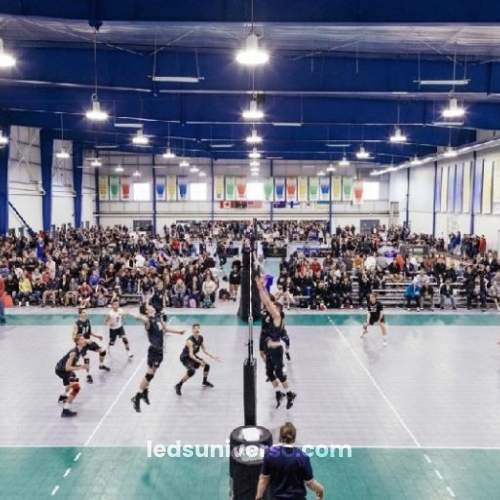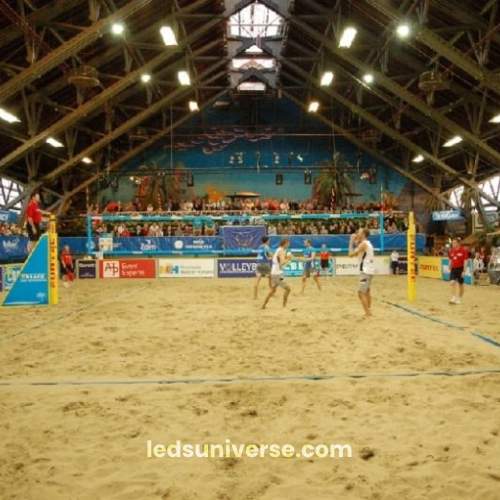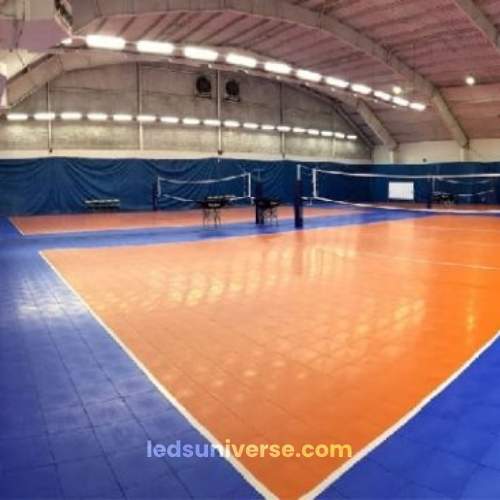Volleyball, whether played in a bustling gymnasium or under the open sky, captivates audiences with its fast-paced action and dynamic plays. However, for the game to truly shine, the court needs more than just a well-maintained surface and skilled players—it requires exceptional lighting.
Volleyball is one of the most popular indoor and outdoor games. Whether it’s an indoor gym or an outdoor court, the right lighting setup enhances visibility, improves player performance, and attracts more spectators. We will delve into various aspects of volleyball court lighting, including types, optimal lighting levels, and brightness, along with installation and cost considerations.
Reach out for free lighting consultation
Table of Contents
Toggle
Indoor volleyball courts require specific lighting solutions to accommodate the needs of players and spectators alike. High-Intensity Discharge (HID) lights, such as Metal Halide and High-Pressure Sodium, have traditionally been used in indoor settings. These fixtures offer strong illumination and are capable of covering large areas. However, they are being increasingly replaced by LED lighting due to its superior efficiency and lower maintenance requirements.
LED lighting has become the preferred choice for indoor volleyball courts. These lights offer several advantages over traditional HID lamps, including better energy efficiency, reduced heat emission, and longer lifespans. They also provide consistent, high-quality light that minimizes glare and shadows, which is essential for players who need clear visibility of the ball and court boundaries.
For outdoor volleyball courts, the lighting setup typically involves fixtures mounted on poles positioned around the court. This setup ensures that the entire playing area is well-lit. High-Intensity Discharge (HID) lights are still commonly used for outdoor courts due to their powerful illumination, but LEDs are becoming more popular due to their energy efficiency and ability to withstand harsh weather conditions.
Outdoor LED lighting must be designed to endure environmental factors such as rain, wind, and temperature fluctuations. The fixtures are often placed on poles located near the corners of the court to provide even coverage and reduce shadows.

To ensure optimal visibility, volleyball courts need to meet specific illuminance requirements. For recreational play, the lighting level is generally around 300 to 500 lux. Competitive play, however, demands higher levels of illumination, typically ranging from 500 to 750 lux. This ensures that players can see the ball clearly and makes the game enjoyable for spectators.
Uniformity in lighting is also crucial. An even distribution of light across the court prevents shadows and glare, which can interfere with the game. This is particularly important in both indoor and outdoor settings to maintain a consistent playing experience.
The brightness of the lighting affects both the players and the audience. For indoor courts, brightness levels should be sufficient to illuminate the entire playing area without creating hotspots or excessively bright areas. In outdoor courts, brightness should be high enough to ensure visibility even under varying weather conditions.
LED lighting provides the advantage of adjustable brightness and beam angles. This allows for customization of the lighting setup to suit different needs and preferences, ensuring that the court is well-lit according to specific requirements.
Installing volleyball court lighting involves careful planning and consideration of various factors, including the type of lighting, placement of fixtures, and cost.

The cost of installing volleyball court lighting can vary widely based on several factors, including the type of lighting selected, the complexity of the installation, and the size of the court. Generally, LED lights, despite their higher initial cost compared to traditional options like High-Intensity Discharge (HID) lamps, prove to be a cost-effective choice in the long run. This is due to their superior energy efficiency and longer lifespan, which result in lower operational and maintenance expenses.
On average, the cost of installing LED lighting for a volleyball court ranges from $1,700 to $2,900 USD. This estimate encompasses the cost of the fixtures themselves, poles or mounting structures, and the labor required for installation. The total expense can fluctuate based on factors such as the court’s dimensions, the specific lighting requirements, and the complexity of the installation process.
Several factors can influence the overall cost of installation. The type of lighting chosen affects the total cost; LED lights, while initially more expensive, offer greater energy savings and durability compared to traditional lighting options. The placement of fixtures also impacts costs. For indoor courts, fixtures are mounted on the ceiling, while outdoor courts require poles for mounting. The number and placement of these fixtures can affect both the cost of the fixtures and the complexity of the installation. Additionally, larger courts require more fixtures to ensure adequate lighting, which can increase costs. The complexity of the installation, including factors such as the height of installation and any necessary structural modifications, can also affect the overall cost.
For indoor volleyball courts, lighting fixtures are typically mounted on the ceiling. The key to effective indoor lighting is to ensure that the fixtures are evenly spaced to provide consistent illumination across the entire court. This prevents uneven lighting conditions that could affect gameplay.
Commonly used wattages for indoor lighting include 100W, 150W, and 200W lamps. The specific wattage and type of fixture chosen will depend on the court’s size and the level of illumination required. LED fixtures are often preferred for their ability to provide bright, uniform light while consuming less power.
The arrangement of the fixtures is crucial. They should be installed at a height and distance that ensures even light distribution, reducing the likelihood of shadows and glare. Proper placement helps maintain visibility for both players and spectators, enhancing the overall experience.
Outdoor volleyball courts require a different approach to lighting. Fixtures are typically mounted on poles situated around the perimeter of the court. This setup ensures that the entire playing area is adequately illuminated, with minimal light spill and shadowing.
Typically, four poles are used, positioned near the corners of the court. Each pole is equipped with multiple fixtures to cover the entire area evenly. The height and placement of these poles are critical to achieving the desired lighting effect. Poles should be tall enough to provide adequate coverage while avoiding excessive light spill beyond the court’s boundaries.
Achieving uniform coverage is essential for both indoor and outdoor courts. Inconsistent lighting can create dark spots or overly bright areas, disrupting gameplay and affecting the experience for players and spectators. Proper fixture placement and beam angles should be used to ensure that light is distributed evenly across the court.
Choosing energy-efficient lighting solutions, such as LED fixtures, can significantly reduce operating costs. LEDs not only consume less power but also have a longer lifespan compared to traditional lighting options. This reduces the frequency of replacements and maintenance, leading to long-term savings.
The durability of lighting fixtures is especially important for outdoor courts, where fixtures are exposed to the elements. High-quality fixtures with weatherproofing and heat dissipation features will last longer and require less maintenance. Regular inspections and upkeep are also necessary to ensure that the lighting system remains in good working condition.
LED lighting has established itself as the premier choice for modern volleyball courts, thanks to its array of benefits. The transition to LED technology offers substantial energy savings—up to 65% less compared to traditional lighting methods such as Metal Halide. This efficiency not only reduces energy bills but also extends the lifespan of the lighting fixtures, minimizing the frequency of replacements and lowering maintenance costs.
When selecting LED lights for a volleyball court, the quality of the LEDs is paramount. Not all LEDs provide the same level of illumination; some may deliver more focused or dimmer light than others. Therefore, it’s crucial to choose LEDs that meet the specific lighting standards required for the court.
Key features to consider include the quality of the light emitted, which should be uniform and bright enough to ensure clear visibility for players. The optical lens of the LED fixtures plays a significant role in controlling the distribution of light. Adjustable beam angles can help tailor the lighting to the court’s needs, ensuring that the light covers the entire playing area effectively while minimizing shadows and glare.
Color temperature is another important factor. The right color temperature enhances visibility and helps players and spectators perceive the game more accurately. For volleyball courts, a neutral to cool white light is often preferred, as it provides a clear and natural view of the court.
One of the major advantages of LED lighting over traditional Metal Halide lamps is its lower energy consumption. LEDs are designed to provide the same level of illumination as Metal Halide fixtures while using significantly less power. This reduction in energy usage not only lowers operational costs but also supports environmental sustainability by reducing the overall carbon footprint.
The design of LED fixtures also impacts their performance and installation. The shape and weight of the fixtures should be considered to ensure that they can be installed securely and effectively. Additionally, the design should facilitate even light distribution across the court to prevent uneven lighting conditions that could affect gameplay.
For outdoor volleyball courts, selecting LED fixtures that are both waterproof and heatproof is essential. Outdoor environments expose lighting fixtures to various weather conditions, including rain, wind, and temperature extremes. High-quality LED fixtures are equipped with built-in heat sinks that manage and dissipate heat, preventing overheating and ensuring the longevity of the lights.
The choice of lighting technology, placement, and brightness levels all contribute to the overall effectiveness of the lighting system. LED lighting, with its energy efficiency, durability, and adjustable features, stands out as the ideal solution for modern volleyball courts. By investing in the right lighting setup and adhering to established standards, court owners can enhance the game experience for players and spectators alike.